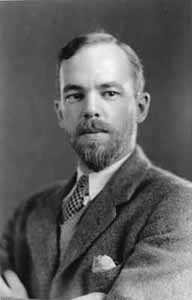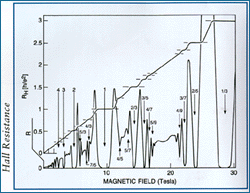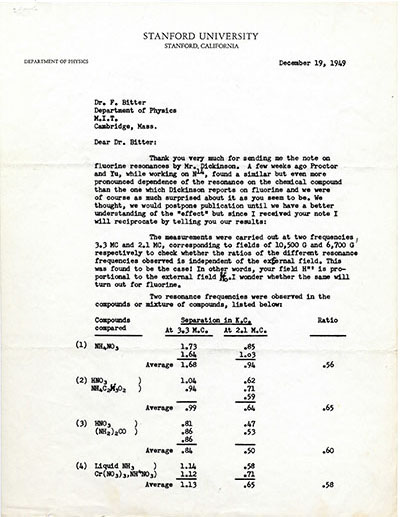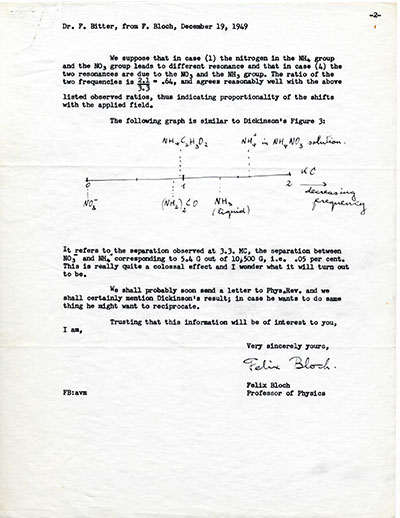"Fractional Quantum Hall Effect" |
Directors |
||||||||
Discovered here at the Francis Bitter Magnet Laboratory by Horst L. Stormer and daniel C. Tsui October 7, 1981 using a 23 tesla Bitter Magnet. For this discovery they and Robert B. Laughlin were awarded the 1998 Noble Prize in Physics. *from Willet, Eisenstein, Stormer, Tsui, Gossard and English, Phys. Rev. Letters 59:15, 1776-9 (1987). |
|
FBML History |
Francis Bitter1902 - 1967 *Photo © American Institute of Physics. |
| |
History of the CMR: The current magnetic resonance program at the FBML originated in the early 1970's and was a response to the acute need for high field NMR facilities in the New England area. It began with the construction of a 7 T, 52 mm bore, multifilamentary NMR magnet and the associated RF electronics. This was the first NMR magnet to be fabricated with multifilamentary NbTi conductor, and was subsequently employed for 11 years for high-resolution solid-state NMR experiments. J.E.C. Williams designed the magnet, and the spectrometer console was designed and assembled by two of us, Griffin and Ruben. In May 1976, the National Institutes of Health (NIH) provided funds to establish a Biotechnology NMR Resource at MIT (RR-00995) with L.J. Neuringer and E.R. Blout as Principal Investigators. Funds from NIH supported the purchase of a commercial 6.4 T (270 MHz) solution NMR spectrometer. This spectrometer was used heavily for 14 years and retired from service in 1989. Functionally, the 270 MHz instrument was replaced with a custom designed console and a 360 MHz widebore solenoid from Oxford Instruments which operates today as a solid state spectrometer. Following completion of the FBML 7T system, work was initiated on an 11.7 T (500 MHz) magnet and spectrometer with support from the NSF to the FBML. The system that emerged in 1979 consisted of a two section NbTi magnet operating at reduced temperature (2.2 K), together with a state-of-the-art electronics console. This spectrometer was one of the first two 500 MHz NMR instruments in operation, and was heavily used until its retirement in 1990. We also note that operation of magnets below 4.2K has become commonplace today to enhance stability. The original console for this spectrometer was replaced in 1985 and updated again in 1990, and at the magnet was replaced with an Oxford Instruments 500/89 system in the early 80’s. Finally, the FBML magnet design group also constructed a 14.1 T (600 MHz) magnet that was first placed in operation in 1992. Because of its compact size (it runs at ~95% of short sample current) this solenoid represented an important innovation in NMR magnet design. In 1993, RR-00995 was renewed for the fourth time, and during the period ‘93-’98 several important changes occurred. First, following the move of the National High Magnetic Field Laboratory (NHMFL) to Florida State University, MIT made a decision to cease operation of the Bitter and Hybrid magnet facilities at the FBML and to vacate and renovate the space that those magnets occupied. Second, the 1994 appearance of 750 MHz high resolution NMR magnets (and now 800 and 900 MHz systems) represented a transition from NMR systems that occupy space in the laboratories of single investigators to magnets that require large multi-story spaces. Accordingly, MIT renovated ~15,000 square feet of two-story laboratory space to house three 700 / 750 MHz magnets. On the level above the 750’s, the 5 gauss line was measured to be about 3 ft above the floor, and thus this space could be used as an ordinary laboratory area. Therefore, this space was reserved for future expansion, so that other high-field NMR magnets could be placed directly above the 750’s, leaving a path between the fringe fields on this floor. Discussions with magnet designers indicated that the effects of the gradients from one magnet on the other could be compensated by the normal superconducting shim systems. A second major change involved the organization of the CMR. Over the past two decades Wagner and Griffin and their research groups have had a continuing interest in experiments involving NMR methodology and its applications to biological systems. These parallel interests have led to numerous discussions, fruitful collaborations, and to sharing of instrumentation and space resources. Most visibly, MIT provided the space to house a 750 MHz NMR spectrometer purchased by Harvard Medical School, and more recently we collaborated on a successful proposal to purchase a 900 MHz instrument. As a consequence of this relationship we decided to formally name the CMR the MIT/Harvard Center for Magnetic Resonance, and we submitted a proposal to the Dean’s offices at each institution. In February 1998, the Harvard and MIT faculties endorsed this proposal, and we have operated in this mode ever since then. In addition to reorganizing the administrative structure of the MIT/Harvard CMR, we also implemented important scientific changes in 1998. These included the following: (1) acquisition of a second 600 MHz spectrometer at the FBML for solution NMR including a cryoprobe and a HRMAS probe; (2) completion of the laboratory space to house a 750/52 MHz system for solution-state spectroscopy and a 750/62 system for solution and solid-state experiments; (3) the renovation of space to accommodate a 700/89 spectrometer for solid state and dynamic nuclear polarization (DNP) experiments; (4) assembly of a DNP spectrometer operating at 250 GHz/380 MHz and a gyrotron operating a 460 GHz (to be used in conjunction with the 700 MHz NMR) ; (5) construction of a 140 GHz pulsed EPR and ENDOR spectrometer which has opened a significant new avenue of scientific inquiry; as anticipated the research activity on these instruments has continued to grow. In 2003, the CMR received funding to purchase a 900 MHz spectrometer to be used for both solution- and solid-state NMR experiments. The instrument was delivered in 2005 and is housed in building NW15 which has space for two 900 MHz /1.2 GHz class magnets. MIT and HMS committed $3.6M for the initial phase of these renovations that will house a single 900 MHz spectrometer. In 2008, the magnet hall above the 750’s was renovated, at a cost $1.2M, to house two new 800 MHz spectrometers. The first of these, a narrow-bore 800 MHz system for solution-state spectroscopy was delivered in 2009; the second, a wide-bore 800 MHz system for solid-state spectroscopy was delivered in 2012. The 800/89 magnet is shielded, and is a zero-boiloff magnet with a superconducting sweep coil. It will be mated with a 527 GHz gyrotron in 2014 and will be one of the highest field DNP spectrometers in operation world wide. |
||
Francis Bitter, Felix Bloch, and the NMR Chemical Shift |






